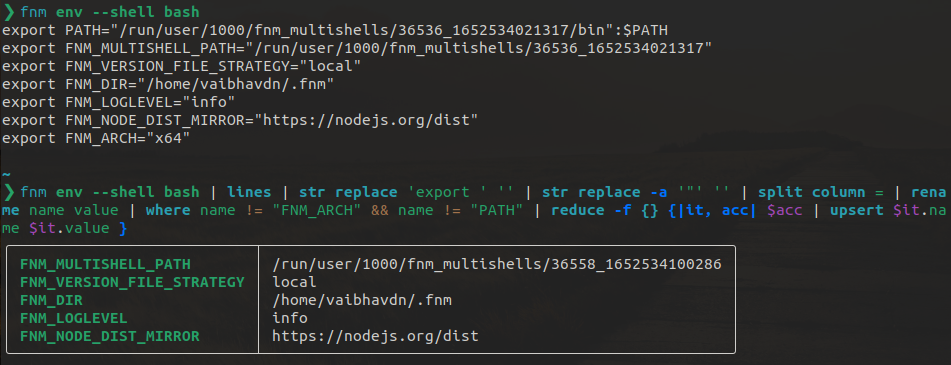A new type of shell
Nushell is a cross-platform shell with a built-in powerful plugin system, but where the Nushell shines is in the way it displays the output.
Outputs are in table format and can be filtered and sorted.
The output of ls command, filtered to display only the directories sorted by recently modified.
FNM - Fast Node Manager
FNM describes itself as a fast and simple Node.JS version manager, built in Rust.
Install and configure FNM
Open the terminal and switch to Nushell.
-
Install FNM using the following command.
curl -fsSL https://fnm.vercel.app/install | bash
- Find the Nushell config by running the following command.
$nu.config-path

- Open the config file in any text editor like vim and add the following lines at the end.
$env.PATH = ($env.PATH | prepend "/home/vaibhavdn/.fnm")
Here we are adding the location where the FNM was installed to the PATH environment.
load-env (fnm env --shell bash | lines | str replace 'export ' '' | str replace -a '"' '' | split column = | rename name value | where name != "FNM_ARCH" && name != "PATH" | reduce -f {} {|it, acc| $acc | upsert $it.name $it.value })
Then we load the FNM_MULTISHELL_PATH
The output of the command used to load FNM_MULTISHELL_PATH

$env.PATH = ($env.PATH | prepend $"($env.FNM_MULTISHELL_PATH)/bin")
Finally we add the loaded FNM_MULTISHELL_PATH to the PATH environment.
Save the file and restart the terminal.
FNM is ready to be used now!!
***
Edit - Nov 2023:
Updated syntax to use $env.PATH in place of let-env PATH. Thanks to @treipatru
***
References
1. https://www.nushell.sh/book/
2. https://github.com/Schniz/fnm
3. https://github.com/Schniz/fnm/issues/463





Top comments (2)
Thanks for the article! The syntax is a bit out of date for version
0.84.0, but with a few changes it works like a charm.Here's the updated config:
Update 2025,
split column "=". You now need quotes around the equals sign